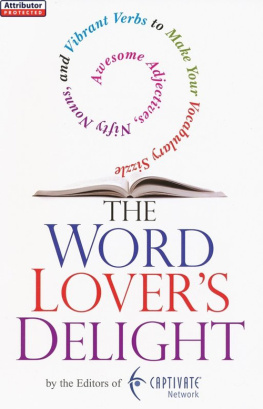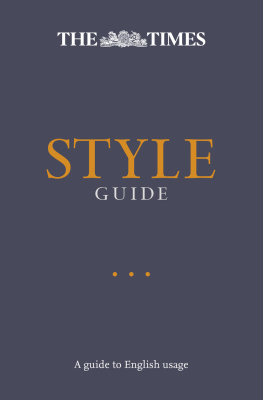JAMA Network Editors - AMA Manual of Style: A Guide for Authors and Editors
Here you can read online JAMA Network Editors - AMA Manual of Style: A Guide for Authors and Editors full text of the book (entire story) in english for free. Download pdf and epub, get meaning, cover and reviews about this ebook. year: 2019, publisher: Oxford University Press, genre: Home and family. Description of the work, (preface) as well as reviews are available. Best literature library LitArk.com created for fans of good reading and offers a wide selection of genres:
Romance novel
Science fiction
Adventure
Detective
Science
History
Home and family
Prose
Art
Politics
Computer
Non-fiction
Religion
Business
Children
Humor
Choose a favorite category and find really read worthwhile books. Enjoy immersion in the world of imagination, feel the emotions of the characters or learn something new for yourself, make an fascinating discovery.
- Book:AMA Manual of Style: A Guide for Authors and Editors
- Author:
- Publisher:Oxford University Press
- Genre:
- Year:2019
- Rating:4 / 5
- Favourites:Add to favourites
- Your mark:
- 80
- 1
- 2
- 3
- 4
- 5
AMA Manual of Style: A Guide for Authors and Editors: summary, description and annotation
We offer to read an annotation, description, summary or preface (depends on what the author of the book "AMA Manual of Style: A Guide for Authors and Editors" wrote himself). If you haven't found the necessary information about the book — write in the comments, we will try to find it.
AMA Manual of Style: A Guide for Authors and Editors — read online for free the complete book (whole text) full work
Below is the text of the book, divided by pages. System saving the place of the last page read, allows you to conveniently read the book "AMA Manual of Style: A Guide for Authors and Editors" online for free, without having to search again every time where you left off. Put a bookmark, and you can go to the page where you finished reading at any time.
Font size:
Interval:
Bookmark:

A Guide for Authors and Editors
11th Edition
Stacy L. Christiansen, MA
Cheryl Iverson, MA
Annette Flanagin, RN, MA
Edward H. Livingston, MD
Lauren Fischer, BA, BS
Connie Manno, ELS
Brenda Gregoline, ELS
Tracy Frey, BA
Phil B. Fontanarosa, MD, MBA
Roxanne K. Young, ELS

Oxford University Press is a department of the University of Oxford. It furthers the Universitys objective of excellence in research, scholarship, and education by publishing worldwide. Oxford is a registered trade mark of Oxford University Press in the UK and certain other countries.
Published in the United States of America by Oxford University Press
198 Madison Avenue, New York, NY 10016, United States of America.
American Medical Association 2020
Tenth Edition published in 2007
All rights reserved. No part of this publication may be reproduced, stored in a retrieval system, or transmitted, in any form or by any means, without the prior permission in writing of Oxford University Press, or as expressly permitted by law, by license, or under terms agreed with the appropriate reproduction rights organization. Inquiries concerning reproduction outside the scope of the above should be sent to the Rights Department, Oxford University Press, at the address above.
You must not circulate this work in any other form and you must impose this same condition on any acquirer.
Library of Congress Cataloging-in-Publication Data
Names: American Medical Association.
Title: AMA manual of style : a guide for authors and editors / JAMA Network editors.
Other titles: Manual of style
Description: 11th edition / Stacy L. Christiansen, Cheryl Iverson, Annette Flanagin,
Edward H. Livingston, Lauren Fischer, Connie Manno, Brenda Gregoline, Tracy Frey,
Phil B. Fontanarosa, Roxanne K. Young. | New York : Oxford University Press, [2020] |
Includes bibliographical references and index.
Identifiers: LCCN 2019028351 (print) | LCCN 2019028352 (ebook) |
ISBN 9780190246556 (hardback) | ISBN 9780190246563 (hardback) | ISBN 9780190246594 (epub)
Subjects: LCSH: Medical writingHandbooks, manuals, etc. | AuthorshipStyle manuals.
Classification: LCC R119.A533 2020 (print) | LCC R119 (ebook) | DDC 808.06/661dc23
LC record available at https://lccn.loc.gov/2019028351
LC ebook record available at https://lccn.loc.gov/2019028352
Identifying the benchmark, the gold standard, in any discipline, is difficult. There are often numerous reference books and well-recognized and validated measures of diseases and disorders, but that single best resource can be elusive. However, the AMA Manual of Style, since its inaugural version in 1962, and with this 11th edition, is truly the standard, and in the words of one colleague, the bible of medical publishing. Written by the editorial staff at JAMA and the JAMA Networkincluding physicians, manuscript editing managers, and current and former managing editorsit is the single most comprehensive text focused solely on medical publishing.
In 2018 I traveled to a meeting held at a start-up that was involved in health and wellness marketing. What did I see5 copies of the AMA Manual of Style. When I asked why so many copies, the response was, They are always in use; it has everything related to medical publishing. What more could we need?
Dangling participles, malapropisms, misuse of hyphens and commas, and capitalization errors: I commit each of these sins daily. Is it two or 2, affect or effect, which or that? Are book titles set in roman or italic type? How do you capitalize and punctuate email? When is causal language appropriate to be used in a research report? Do I use an SI unit or a conventional unit? What is the best way to display data? How do I handle an author dispute or determine if permission to republish part of a figure is needed? Was the correct statistical analysis used for a specific study? These puzzling questions come up every day in medical publishing and manuscript editing. The AMA Manual of Style answers these questions and thousands more.
Communication of medical information has changed radically over the past decade. The emergence of the internet and digital publishing changed forever how information is communicated. Reliance on a print copy of a journal is no more. The content of many journals is now pushed to many audiences via the internet, social media, news media, and email (or e-mail, which is it? see ). Transmission of information, which used to be confined to the printed word, now includes online synopses of articles, podcasts, videos, visual abstracts, and content translated into other languages. In the chapters on Manuscript Preparation; References; Editorial Assessment and Processing; Editing, Proofreading, Tagging, and Display; and the Glossary of Publishing Terms many of these new forms of communication are discussed.
The book is comprehensive. Since the publication of the last edition, old issues, including conflict of interest and scientific misconduct, have reemerged with additional and important concerns. New and evolving issues, such as open access, preprint servers, team science, open peer review, data sharing, and new rules for protecting participants rights in research have come to the fore. These and related issues are discussed in depth in the chapter Ethical and Legal Considerations and are also addressed in the chapters on Manuscript Preparation and Editorial Assessment and Processing.
For an author, editor, or publisher working in the field of medical publishing, the 23 chapters in this volume should help answer questions that arise in daily work as well as those that occur infrequently. There is guidance on citing sources; data displays (graphical and tabular); grammar, punctuation, plurals, and capitalization; correct and preferred usage; abbreviations; nomenclature (from genetics to organisms to oncology); copyright, licensing, and permissions; units of measure; numbers, study design, and statistics; equations; and electronic editing and proofreading. The book concludes with a list of other resources that may be helpful to authors and editors.
During my tenure I have had the good fortune of working with some great writersDon Berwick, Tony Fauci, Phil Fontanarosa, Larry Gostin, Mary McDermott, Abraham Verghese, and Jody Zylke. For them I suspect writing comes naturally; they are simply gifted communicators. But for most people, writingparticularly medical writingis a learned skill. There are many nuances, including high-level organizational structure, reporting standards, and correct usage of medical terminology, as well as paragraph transitions, syntax, word choice, verb tense, and punctuation use. For the vast majority of authors and editors of scientific communication, this edition of the AMA Manual of Style will be of great assistance.
It has been my privilege to work with the authors of this book. They have taught me much about medical editing and publishing. In the field of medical journalism and communication, the AMA Manual of Style is indispensable. It should be on the shelf of every editor and publisher and available to authors worldwide.
Howard Bauchner, MD
Editor in Chief
JAMA
Font size:
Interval:
Bookmark:
Similar books «AMA Manual of Style: A Guide for Authors and Editors»
Look at similar books to AMA Manual of Style: A Guide for Authors and Editors. We have selected literature similar in name and meaning in the hope of providing readers with more options to find new, interesting, not yet read works.
Discussion, reviews of the book AMA Manual of Style: A Guide for Authors and Editors and just readers' own opinions. Leave your comments, write what you think about the work, its meaning or the main characters. Specify what exactly you liked and what you didn't like, and why you think so.










